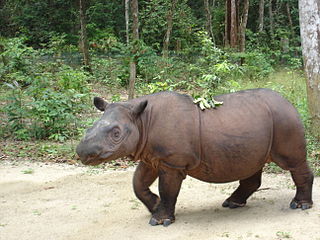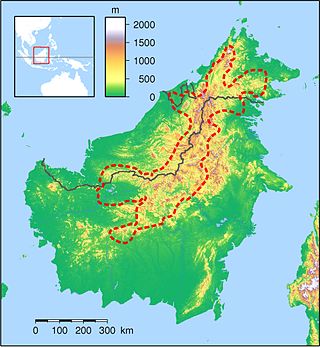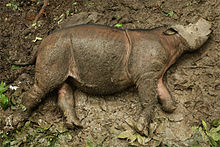
The bay cat, also known as the Bornean bay cat, is a small wild cat endemic to the island of Borneo that appears to be relatively rare compared to sympatric wild cats, based on the paucity of historical, as well as recent records. Since 2002, it has been listed as Endangered on the IUCN Red List because it is estimated that fewer than 2,500 mature individuals exist, and that the population declined in the past. The bay cat has been recorded as rare and seems to occur at relatively low density, even in pristine habitat.

The Javan rhinoceros, Javan rhino, Sunda rhinoceros or lesser one-horned rhinoceros is a critically endangered member of the genus Rhinoceros, of the rhinoceros family, Rhinocerotidae, and one of the five remaining extant rhinoceros species across South Asia and Africa. The Javan rhinoceros is one of the smallest rhinoceros species, along with the Sumatran, or "hairy", rhinoceros. They are superficially similar to Indian one-horned rhinos, as they have plate-like, "armored" protective skin folds, but are slightly smaller in size, at just 3.1–3.2 m (10–10 ft) long and 1.4–1.7 m (4.6–5.6 ft) tall, on average. The heaviest specimens weigh around 2,300 kg/2.3 tonnes, similar to an African black rhinoceros. However, unlike the long and potentially lethal horns of the black or white rhinoceroses of Africa, the Javan species' single, somewhat blunted horn is usually shorter than 25 cm (9.8 in).

The Sumatran rhinoceros, also known as the Sumatran rhino, hairy rhinoceros or Asian two-horned rhinoceros, is a rare member of the family Rhinocerotidae and one of five extant species of rhinoceros; it is the only extant species of the genus Dicerorhinus. It is the smallest rhinoceros, although it is still a large mammal; it stands 112–145 cm (44–57 in) high at the shoulder, with a head-and-body length of 2.36–3.18 m and a tail of 35–70 cm (14–28 in). The weight is reported to range from 500–1,000 kg (1,100–2,200 lb), averaging 700–800 kg (1,540–1,760 lb). Like both African species, it has two horns; the larger is the nasal horn, typically 15–25 cm (5.9–9.8 in), while the other horn is typically a stub. A coat of reddish-brown hair covers most of the Sumatran rhino's body.

A rhinoceros, commonly abbreviated to rhino, is a member of any of the five extant species of odd-toed ungulates in the family Rhinocerotidae; it can also refer to a member of any of the extinct species of the superfamily Rhinocerotoidea. Two of the extant species are native to Africa, and three to South and Southeast Asia.

The white rhinoceros, white rhino or square-lipped rhinoceros is the largest extant species of rhinoceros. It has a wide mouth used for grazing and is the most social of all rhino species. The white rhinoceros consists of two subspecies: the southern white rhinoceros, with an estimated 16,803 wild-living animals, and the much rarer northern white rhinoceros. The northern subspecies has very few remaining individuals, with only two confirmed left in 2018, both in captivity. Sudan, the world's last known male Northern white rhinoceros, died in Kenya on 19 March 2018 at age 45.

The Tabin Wildlife Reserve is a nature preserve in Sabah, Malaysia. It was created in 1984 to preserve Sabah's disappearing wild animals. Occupying a large part of the peninsula forming the northern headland of Darvel Bay, it is located 48 kilometres east of Lahad Datu.

The Borneo elephant, also called the Bornean elephant or the Borneo pygmy elephant, is a subspecies of Asian elephant (Elephas maximus) that inhabits northeastern Borneo, in Indonesia and Malaysia. Its origin remains the subject of debate. A definitive subspecific classification as Elephas maximus borneensis awaits a detailed range-wide morphometric and genetic study. Since 1986, the Asian elephant has been listed as Endangered on the IUCN Red List as the population has declined by at least 50% over the last three generations, estimated to be 60–75 years. It is pre-eminently threatened by loss, degradation and fragmentation of habitat.

The Bornean orangutan is a species of orangutan endemic to the island of Borneo. Together with the Sumatran orangutan and Tapanuli orangutan, it belongs to the only genus of great apes native to Asia. It is the largest of the three species of orangutans. Like the other great apes, orangutans are highly intelligent, displaying tool use and distinct cultural patterns in the wild. Orangutans share approximately 97% of their DNA with humans. Also called mias by the local population, the Bornean orangutan is a critically endangered species, with deforestation, palm oil plantations, and hunting posing a serious threat to its continued existence.

The Sunda clouded leopard is a medium-sized wild cat native to Borneo and Sumatra. It is listed as Vulnerable on the IUCN Red List since 2015, as the total effective population probably consists of fewer than 10,000 mature individuals, with a decreasing population trend. On both Sunda Islands, it is threatened by deforestation. It was classified as a separate species, distinct from the clouded leopard in mainland Southeast Asia based on a study in 2006. Its fur is darker with a smaller cloud pattern.

The Bornean clouded leopard is a subspecies of the Sunda clouded leopard. It is native to the island of Borneo, and differs from the Batu-Sumatran clouded leopard in the shape and frequency of spots, as well as in cranio-mandibular and dental characters. In 2017, the Cat Classification Taskforce of the Cat Specialist Group recognized the validity of this subspecies.

The wildlife of Malaysia is diverse, with Malaysia being a megadiverse country. Most of the country is covered in rainforest, which hosts a huge diversity of plant and animal species. There are approximately 361 mammal species, 694 bird species, 250 reptile species, and 150 frog species found in Malaysia. Its large marine territory also holds a great diversity of life, with the country's coastal waters comprising part of the Coral Triangle.

The International Rhino Foundation (IRF) is a Texas-based charity focused on the conservation of the five species of rhinoceros which include the White Rhinoceros and Black Rhinoceros of Africa, and the Indian Rhinoceros, Javan Rhinoceros and Sumatran Rhinoceros of Asia.
Francesco Romano Nardelli is an Italian naturalist who has dedicated his life to the protection and conservation of endangered species. He is also the co-founder, with John Aspinall, of the Sumatran Rhino Project, one of the most important coordinated efforts to save a critically endangered species.

The Borneo montane rain forests is an ecoregion on the island of Borneo in Southeast Asia. It includes montane tropical and subtropical moist broadleaf forests, also known as a cloud forests. The ecoregion is partly in East Malaysia and Indonesia (Kalimantan).

The Heart of Borneo is a conservation agreement initiated by the World Wide Fund for Nature to protect a 220,000 km² forested region on Borneo island. The agreement was signed by the governments of Brunei, Indonesia and Malaysia in Bali on 12 February 2007 to support the initiative. The region provides habitat to 10 endemic species of primates, more than 350 birds, 150 reptiles and amphibians and 10,000 plants. From 2007 to 2010 a total of 123 new species have been recorded in the region. A status report from 2012 found that the lowland rain forest within the area is deteriorating and under threat. The Bornean rhinoceros was the most threatened fauna, in 2015 three captive individuals remained in Sabah.

The Northern Sumatran rhinoceros, also known as Chittagong rhinoceros or northern hairy rhinoceros, was the most widespread subspecies of Sumatran rhinoceros, as well as the only known subspecies native to mainland Asia.

A hybrid orangutan or cocktail orangutan is usually an orangutan derived from interbreeding between any of the three Orangutan species: Bornean, Sumatran and Tapanuli, but the term "hybrid orangutan" could also refer to hybrids of the three known Bornean subspecies. As of 2015, there are approximately 134 living Bornean x Sumatran hybrid orangutans in captivity.

There are three species of orangutan. The Bornean orangutan, the most common, can be found in Kalimantan, Indonesia and Sarawak and Sabah in Malaysia. The Sumatran orangutan and the Tapanuli orangutan are both only found in Sumatra, Indonesia. The conservation status of all three of these species is critically endangered, according to the International Union for Conservation of Nature (IUCN) Red List.

The western Sumatran rhinoceros is a subspecies of the Sumatran rhinoceros that is native to Sumatra, primarily within these Indonesian national parks: Bukit Barisan Selatan National Park, Kerinci Seblat National Park, Mount Leuser National Park, and its population is partially remaining in Way Kambas National Park. The subspecies went extinct in the Malaysian Peninsula. Its population is limited, with only around 275 rhinos left in the wild, from which they are being threatened by poaching, and occasional habitat loss. A few individuals are being held and bred in captivity within the Sumatran Rhino Sanctuary, and in the Cincinnati Zoo and Botanical Garden.



















